

Amazon Basin-wide fluxes of CO 2 and CH 4 from aircraft vertical profiles ( with support from CO and SF 6 ) John B. Miller, Luciana Gatti, Manuel Gloor, and Luana Basso
Amazonian (and tropical) C-cycle is critical to understanding the global C-cycle This spread, a first-order uncertainty in climate prediction , is largely a function of Amazonian In coupled, climate, carbon-cycle response to climate. (Fire, (C 4 ) models deforestation, hydrological feedbacks all play a role). Friedlingstein et al, 2006, J. Clim. We can quantify relationships between Carbon flux and climate over annual to decadal periods with accurate observations of both.
Amazonian C fluxes are underconstrained, because we don’t have enough obs in the right places
Large Temp and Moisture Anomalies in 2010; 2011 returned to ‘normal’ Temperature Precipitation Gatti et al., Nature, 2014
Aircraft vertical profiles sensitive to a large fraction of Amazonia. • Aircraft vertical profiles from the surface to 4.4 km • Sampling every two weeks. • Measurements of CO2, CO and SF6 (also other gases) at Gatti lab in Sao Paulo. Measurements • are differenced from Atlantic sites. Gatti et al., Nature, 2014
Vertical profiles are collected using light aircraft Analysis system at Gatti Lab in Sao Paulo PFP and PCP
IPEN measurements are highly precise and compatible with NOAA’s Long term stability and accuracy better than 0.1 ppm (2 sigma).
Calculation of Amazonian site background using SF 6 By comparing vertical profiles of SF 6 with background SF 6 , we can determine the relative influence of Northern and Southern Hemisphere air. These fractions can then be applied to other gases to determine their background. Emissions ASC RPB 0 2x10 5 Atmosphere ‘ No ’ SF6 Emissions in Amazonia
Average CO 2 and CO profiles by season show wet season uptake and dry season emission – but dry season emission is largely due to fire. ∆ CO2 = CO2 site – CO2 background
How we calculate fluxes of CO2 and CO… …a 5 millon km 2 flux chamber (with a leaky top) ∆ X = X site - X bg t = residence time of air on continent r CO2:CO = emission ratio of fires (detected from obvious fire plumes) bio = F CO in wet season F CO
Basinwide CO 2 Fluxes Gatti et al., Nature, 2014
Comparison to independent CO 2 fluxes 1. RAINFOR forest inventory plots give long term uptake of -0.4 PgC/yr 1. We find -0.25 in 2011, but this includes deforestation respiration. (i.e. deforestation is more than just fire.) 2. If we assume a 2:1 ratio of fire:respiration in deforestation, then F NEE = -0.25 – 0.3/2 = -0.4 2. GFED fire emissions are +0.5 and +0.1 PgC/yr in 2010 and 2011. 1. We observe +0.5 and +0.3 PgCyr.
Basinwide CH 4 Fluxes
Basinwide CH 4 Fluxes
Comparison to independent CH 4 fluxes 1. Kirschke et al (2013) Tropical S. America 1. Top-down: 20-45 Tg CH4/yr 2. Bottom-up: 40-90 Tg CH4/yr 3. This study: 30 and 40 Tg CH4/yr 2. Bottom-up models can not reproduce the spatial pattern we see: high fluxes in the east. 3. Will modeled fluxes show higher emissions in 2010 than 2011?
Conclusions 1. CO 2 a. Moisture may be more significant than temperature in controlling Amazonian CO 2 flux (in contrast to Cox et al, Nature, 2013) b. Leaky box top – how does convection impact fluxes? More work needed to quantify these losses. Seasonality is likely bigger than currently estimated. c. Basinwide seasonality shows wet season net uptake. 2. CH 4 a. Basinwide fluxes are similar to other top-down estimates, but spatial patterns are different. b. Higher 2010 (dry year) fluxes remains a mystery. Sustained monitoring is needed to understand climate – carbon relationships (and thus have some confidence in future predictions).
CO time series
Amazonian C flux is currently woefully under-constrained The “Residual dumping ground” of global inversions -- Prof. Denning Gurney et al., 2002, Nature Ometto et al., 2005, Oecologia S. American estimates vary widely …not so for the temperate north, especially in the last ~ 5 years (more obs).
Large Trends in Amazonian Climate • Amazon temperatures rising over the last 20 years • as everywhere else rising CO 2 • and there are also changes in the hydrological cycle: general upward trend, with dryer dry seasons and wetter wet seasons Gloor et al. 2013, GRL
Amazonian (and tropical) C-cycle is critical to understanding the global C-cycle While stocks and gross NPP Resp fluxes aren’t predictors of net fluxes, they are Net Flux keys to capacity for What we see future changes. SiB-CASA (K. Schaefer) Stocks… (~25%) MODIS EVI Annual …and Gross “Fluxes” (~15%)
Intensive Forest Plot Results show drought suppressed GPP in 2010. Plant Carbon Expenditure = NPP + R auto ≈ GPP
Flux signals observed by site. -- Make new bar graph showing Basin Averages Total, Burning, Non-fire, for 2010 and 2011
Basinwide Fluxes
Recommend
More recommend